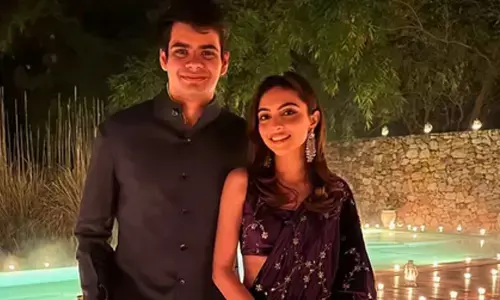Will Telangana revive ancient art form Perini Natyam?

Will Telangana Revive Ancient Art form Perini Natyam?. Perini Prakash was twenty when he began his journey into Perini Natyam. One day, he accidentally heard late Dr. Natraja Ramakrishna’s speech in Sircilla Taluk, Karimnagar in a loud speaker from across the street where he was waiting to catch a bus to go home.
Perini Prakash was twenty when he began his journey into Perini Natyam. One day, he accidentally heard late Dr. Natraja Ramakrishna’s speech in Sircilla Taluk, Karimnagar in a loud speaker from across the street where he was waiting to catch a bus to go home. But, well, such was Dr. Ramakrishna’s influence, Prakash left home for good to live and train with the master himself. And the rest as they say is history. Like teacher like student, Perini Prakash lives and breathes dance. His wife, Suneela Prakash has trained in Perini Lasyam.
.jpg)
I walk into the dancer-couple’s house and, the first thing that catches my attention is a life-size portrait of their teacher and numerous trophies. “They are our teacher’s!” Prakash says proudly.
To say Dr. Ramakrishna was a Padmashri-awardee might be an understatement. “He was an encyclopaedia on dance. And he devoted a whole lifetime to dance, teaching it and studying it.” His students were his children and his only family.
As many as 700 years after the dance form perished and almost faded in peoples’ memory, he revived Perini Natyam to its present form and fame. Suneela Prakash explains how “he travelled all over Andhra Pradesh and met court dancers. He studied sculptures on temple panels in Warangal and more importantly, dance treatises by Jayapa Senani and Nandikesvara – Nritta Ratnavali and Bharatarnava. And finally, he matched his research with his own imagination and impeccable knowledge of sound and vibration, and gave the dance form a new lease of life.”
Perini natyam has a rich and interesting history going back nearly a thousand years. The dancer-couple dates it back to the reign of the Eastern Chalukyas, where it seemed to have been birthed. It flourished, however, during the Kakatiyas’ rule – particularly during the time of Emperors Ganapati Deva, Rudrama Devi and Prataparudra, between the 10th and 13th centuries. Jayapa Senani penned his Nritta Ratnavali in this period.
This once-forgotten dance is unique among other classical dance forms, in the sense that it has a fully evolved male-oriented solo dance technique, “which is Perini Siva Thandavam. Perini Lasyam is the feminine component that women performed in temples and the courts of kings.” (Seen here in the picture taken at Kothapally, Karimnagar).

And, I wonder how the dance got its name, Perini. We know Kuchipudi is named after the place where it was born. So is there a place by the name Perini, I ask. Then Prakash chips in, “the Siva Thandavam would be performed before the Kakatiya warriors, when they were about to set out to battle, to “invoke” (which in Telugu translates into “prerana”) the spirit and courage of Siva in them. Hence, the name Perini.” Perini Thandavam is very intense and powerful. Apart from the great amount of legwork, speed, and movements of various parts of the body in isolation, the accompanying music transports the audience into another world. “In three minutes, the dancer is drenched in sweat!” he adds.
Suneela elaborates that most temples built during the reign of the Kakatiyas had what is called a rangasila, or a stone platform used for dance performance, before the garbhagudi or sanctum-sanctorum, and that dance was an essential part of deity worship. “The entrance panels of the sanctum carry sculptures of musicians with various instruments.” And in an ancient temple built by Ganapati Deva in Kuchimanchi, Khammam district, they found sculptures of male Perini dancers on temple walls, from where they could discern the costumes that were worn at the time. “This is proof enough that there was a thriving dance form in this region, which is now Telangana.”
The husband and wife have travelled across all the ten districts of Telangana, visiting more such temples, dusting away the cobwebs that gathered over centuries, collecting pictographic evidence, and meeting local Perini dancer-teachers. They have put their work together into a book, which is set for release later this month, on their teacher’s birthday. A fitting tribute and guru-dakshina indeed!

“We do all we can to raise awareness. From Kashmir to Kanyakumari, I have performed all over India,” As though that is not enough, he toured twelve states in the USA last year, where his former students are keeping the tradition alive, and he is gearing up for another tour later this year. He also has been to Dubai, Indonesia, Malaysia, Nepal, Singapore, UK among others. “We want people to know and talk of Perini Natyam in the same vein as Kuchipudi or Bharatanatyam.”
Post the state bifurcation, Perini dancers are hopeful that the new state will give Perini Natyam its rightful recognition and pride of place as a classical dance form of Telangana.
As we are about to wrap up our conversation, Prakash pulls out photographs of his previous performances, and classes he taught. In one of them, he is teaching a group of 80 young boys in a school in Hyderabad. “Eighty, no less. And not one of them has taken to the dance after that. All of them are now either doctors or engineers or cricketers!”
Indu Chinta














